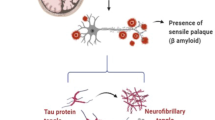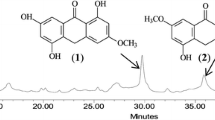Abstract
Memory deficits associated with neurologically degenerative disorders including Alzheimer’s disease may be partly due to impairment of cholinergic neurotransmission implying that drugs acting as acetylcholinesterase inhibitors are the focus of many therapeutic strategies. Huperziaceae and Lycopodiaceae species have been used in traditional Chinese medicine for the treatment of memory deficiencies. Alkaloids produced by these club mosses species have been shown to produce positive effects on learning and memory. Natural plants are up to now the main source of these compounds and may soon become extinct if harvest practices are not curtailed. Alternative production methods of Lycopodiales alkaloids by plant cell cultures are therefore of growing interest. Previously established in vitro cultures of Lycopodiella inundata have been shown to produce alkaloids but cell growth was very slow. Since plant growth regulators (PGRs) are one of the most important factors affecting cell growth, differentiation and metabolite production, we investigated different cytokinins and auxins, alone or in combination, supplemented in solid media. The aim was to determine their effects on biomass increase and on alkaloids accumulation in plant cell cultures of Lycopodiella inundata. Results analyzed with response surface methodology showed that all PGRs and their interactions strongly affected the plant cell cultures: biomass has been increased by a factor of 5 in 4 months and alkaloid level, closely correlated to PGRs added in culture media, reached 1 % (alkaloid weight/DW) for the optimal conditions. This optimization would be beneficial to large-scale biomass obtention and secondary metabolites production for this species.









Similar content being viewed by others
References
Abdul Jaleel C, Gopi R, Gomathinayagam M, Panneerselvam R (2009) Traditional and non-traditional plant growth regulators alters phytochemical constituents in Catharanthus roseus. Process Biochem 44:205–209
Atmane N, Blervacq AS, Michaux-Ferriere N, Vasseur J (2000) Histological analysis of indirect somatic embryogenesis in the Marsh clubmoss Lycopodiella inundata (L.) Holub (Pteridophytes). Plant Sci 156:159–167
Cooke TJ, Poli D, Sztein AE, Cohen JD (2002) Evolutionary patterns in auxin action. Plant Mol Biol 49:319–338
Davies KM, Deroles SC (2014) Prospects for the use of plant cell cultures in food biotechnology. Curr Opin Biotechnol 26:133–140
Docimo T, Davis AJ, Luck K, Fellenberg C, Reichelt M, Phillips M, Gershenzon J, D’Auria JC (2015) Influence of medium and elicitors on the production of cocaine, amino acids and phytohormones by Erythroxylum coca calli. Plant Cell Tiss Organ Cult 120:1061–1075
Döring AS, Petersen M (2014) Production of caffeic, chlorogenic and rosmarinic acids in plants and suspension cultures of Glechoma hederacea. Phytochemistry Lett 10:cxi–cxvii. doi:10.1016/j.phytol.2014.05.012
Hand C, Maki S, Reed BM (2014) Modeling optimal mineral nutrition for hazelnut micropropagation. Plant Cell Tiss Organ Cult 119:411–425
Jiang H, Luo X, Bai D (2003) Progress in clinical, pharmacological, chemical and structural biological studies of huperzine A: a drug of traditional Chinese medicine origin for the treatment of Alzheimer’s disease. Curr Med Chem 10:2231–2252
Kolewe ME, Gaurav V, Roberts SC (2008) Pharmaceutically active natural product synthesis and supply via plant cell culture technology. Mol Pharm 5:243–256
Langhansova L, Marsik P, Vanek T (2012) Regulation of tissue differentiation by plant growth regulators on tTCLs of Panax ginseng adventitious roots. Ind Crops Prod 35:154–159
Liang SZ, Zhong JJ, Yoshida T (1991) Review of plant cell culture technology for producing useful products (part I). Ind Microbiol 21:27–31
Luczkiewicz M, Kokotkiewicz A, Glod D (2014) Plant growth regulators affect biosynthesis and accumulation profile of isoflavone phytoestrogens in high-productive in vitro cultures of Genista tinctoria. Plant Cell Tiss Organ Cult 118:419–429
Ma X, Gang DR (2008) In vitro production of huperzine A, a promising drug candidate for Alzheimer’s disease. Phytochemistry 69:2022–2028
Menendez V, Villacorta NF, Revilla MA, Gotor V, Bernard P, Fernandez H (2006) Exogenous and endogenous growth regulators on apogamy in Dryopteris affinis (Lowe) Fraser-Jenkins sp. affinis. Plant Cell Rep 25:85–91
Murashige T, Skoog F (1962) A revised medium for rapid growth and bio-assays with tobacco tissue cultures. Physiol Plant 15:473–497
Murthy HN, Lee EJ, Paek KY (2014) Production of secondary metabolites from cell and organ cultures: strategies and approaches for biomass improvement and metabolite accumulation. Plant Cell Tiss Organ Cult 118:1–16
Nosov AM (2012) Application of cell technologies for production of plant derived bioactive substances of plant origin. Appl Biochem Microbiol 48:609–624
Orhan I, Sener B (2003) Acetylcholinesterase inhibitors from natural resources. J Pharm Sci 28:51–58
Racchi M, Mazzucchelli M, Porrello E, Lanni C, Govoni S (2004) Acetylcholinesterase inhibitors: novel activities of old molecules. Pharmacol Res 50:441–451
Raj D, Kokotkiewicz A, Drys A, Luczkiewicz M (2015) Effect of plant growth regulators on the accumulation of indolizidine alkaloids in Securinega suffruticosa callus cultures. Plant Cell Tiss Organ Cult. doi:10.1007/s11240-015-0811-6
Rhee IK, van de Meent M, Ingkaninan K, Verpoorte R (2001) Screening for acetylcholinesterase inhibitors from Amaryllidaceae using silica gel thin-layer chromatography in combination with bioactivity staining. J Chromatogr A 915:217–223
Sener B, Orhan I (2005) Discovery of drug candidates from some Turkish plants and conservation of biodiversity. Pure Appl Chem 77:53–64
Szypula W, Pietrosiuk A, Suchocki P, Olszowska O, Furmanowa M, Kazimierska O (2005) Somatic embryogenesis and in vitro culture of Huperzia selago shoots as a potential source of huperzine A. Plant Sci 168:1443–1452
Van Staden J, Zazimalova E, George EF (2008) Plant growth regulators II: cytokinins, their analogues and antagonists. In: George EF, Hall MA, Klerk GJ (eds) Plant propagation by tissue, vol 1. The background culture. Springer, Dordrecht, pp 205–226
Verpoorte R, van der Heijden R, van Gulik WM, ten Hoopen HJG (1991) Plant biotechnology for the production of alkaloids: present status and prospects. In: Brossi A (ed) The alkaloids: chemistry and pharmacology, vol 40. Academic Press, San Diego, pp 1–187
Whittier DP (1998) Germination of spores of the Lycopodiaceae in axenic culture. Am Fern J 88:106–113
Williams P, Sorribas A, Howes M-JR (2011) Natural products as a source of Alzheimer’s drug leads. Nat Prod Rep 28:48–77
Zhang HY, Zheng CY, Yan H, Wang ZF, Tang LL, Gao X, Tang XC (2008) Potential therapeutic targets of huperzine A for Alzheimer’s disease and vascular dementia. Chem Biol Interact 175:396–402
Author information
Authors and Affiliations
Corresponding author
Rights and permissions
About this article
Cite this article
Bienaimé, C., Melin, A., Bensaddek, L. et al. Effects of plant growth regulators on cell growth and alkaloids production by cell cultures of Lycopodiella inundata . Plant Cell Tiss Organ Cult 123, 523–533 (2015). https://doi.org/10.1007/s11240-015-0856-6
Received:
Accepted:
Published:
Issue Date:
DOI: https://doi.org/10.1007/s11240-015-0856-6




